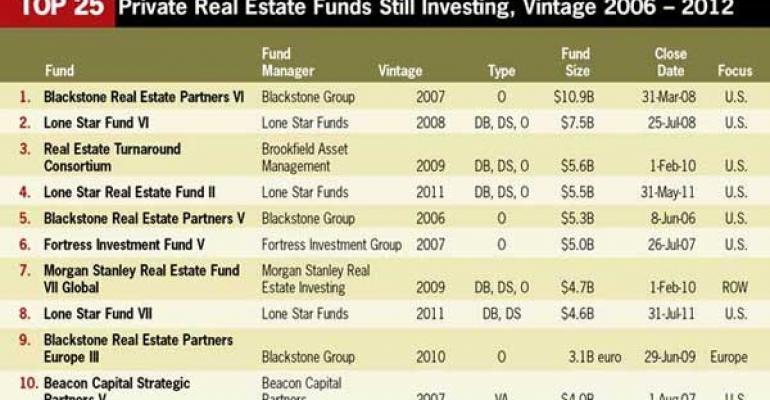In early February, private equity giant Blackstone purchased a portfolio of U.K. industrial properties from logistics REIT Prologis Inc. in a $335 million deal. Less than one month earlier, Blackstone, along with DDR Corp., had acquired 46 shopping centers from EPN Group—the third major retail portfolio the firm has acquired in less than 12 months.
Perhaps that shouldn’t be a surprise considering that Blackstone alone has three of the 10 largest private real estate funds that are actively investing, including the single largest, Blackstone Real Estate Partners VI, according to Preqin, an alternative assets research firm. And if all goes to plan, the firm will eclipse its own mark with its Blackstone Real Estate Partners VII fund, which has raised more than $6 billion to date and will continue fundraising until February 2013.
Aside from Blackstone, another three of the 10 largest funds investing today are operated by Lone Star Funds. Collectively, the top 25 funds still investing have a total capacity of more than $100 billion. A good part of that is invested, but many of the funds have plenty of buying capacity remaining. And they play in all aspects of the commercial real estate quality stack.
These existing funds are being joined by new competitors every day. In 2011, 126 new funds were raised with an aggregate commitment of $48.7 billion and average $416 million. That’s a respectable amount, but well below the peak years of 2007 and 2008 when 345 and 295 funds were raised with aggregate commitments of $137.4 billion and $140.8 billion.
The average fund size declined in 2009 and 2010 as a result of investor caution and inactivity following the downturn, according to Andrew Moylan, manager-real estate with Preqin in London. The average fund size did increase in 2011, although not to the levels seen in 2008, according to Moylan.
Overall, of the funds closed in 2011, 41 were the second or third funds for a manager and 49 were the fourth or more. There were also 35 funds raised by first-timers.
The first-time fund managers, however, tended to raise less money than their more experienced counterparts. Managers raising at least their fourth fund had aggregate commitments of $30.1 billion and an average fund size of more than $600 million. Those raising a second or third fund raised an aggregate of $12.1 billion with an average fund size of just less than $300 million. The first-timers, in contrast, raised an aggregate $6.5 billion for an average fund size of less than $200 million.
“The largest funds will almost always be raised by more experienced firms,” Moylan says. “New firms make up a significant number of the funds raised, but tend to raise less capital than firms with a longer track record.”
Many of the funds going today were raised prior to the credit crisis and recession. Since then the balance of funds has changed.
In 2011, 28 percent of the funds closed are targeting debt, 17 percent are looking for distressed assets, 25 percent are opportunist, 17 percent are value-added. Just 13 percent are core or core-plus funds.


